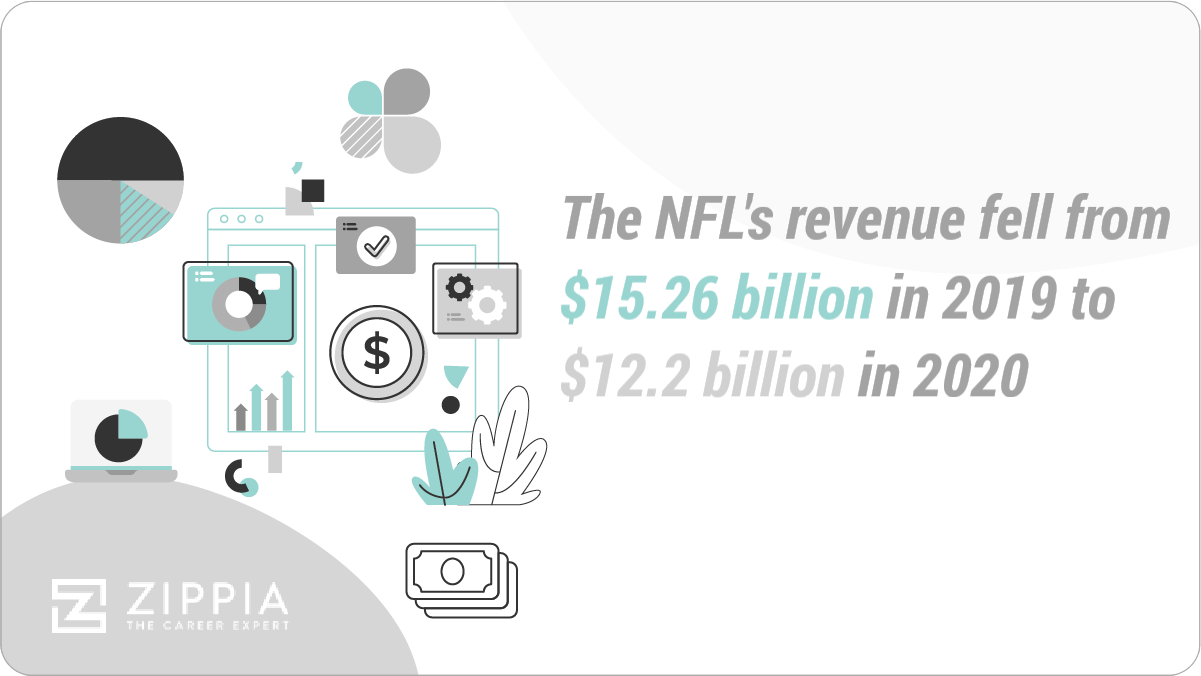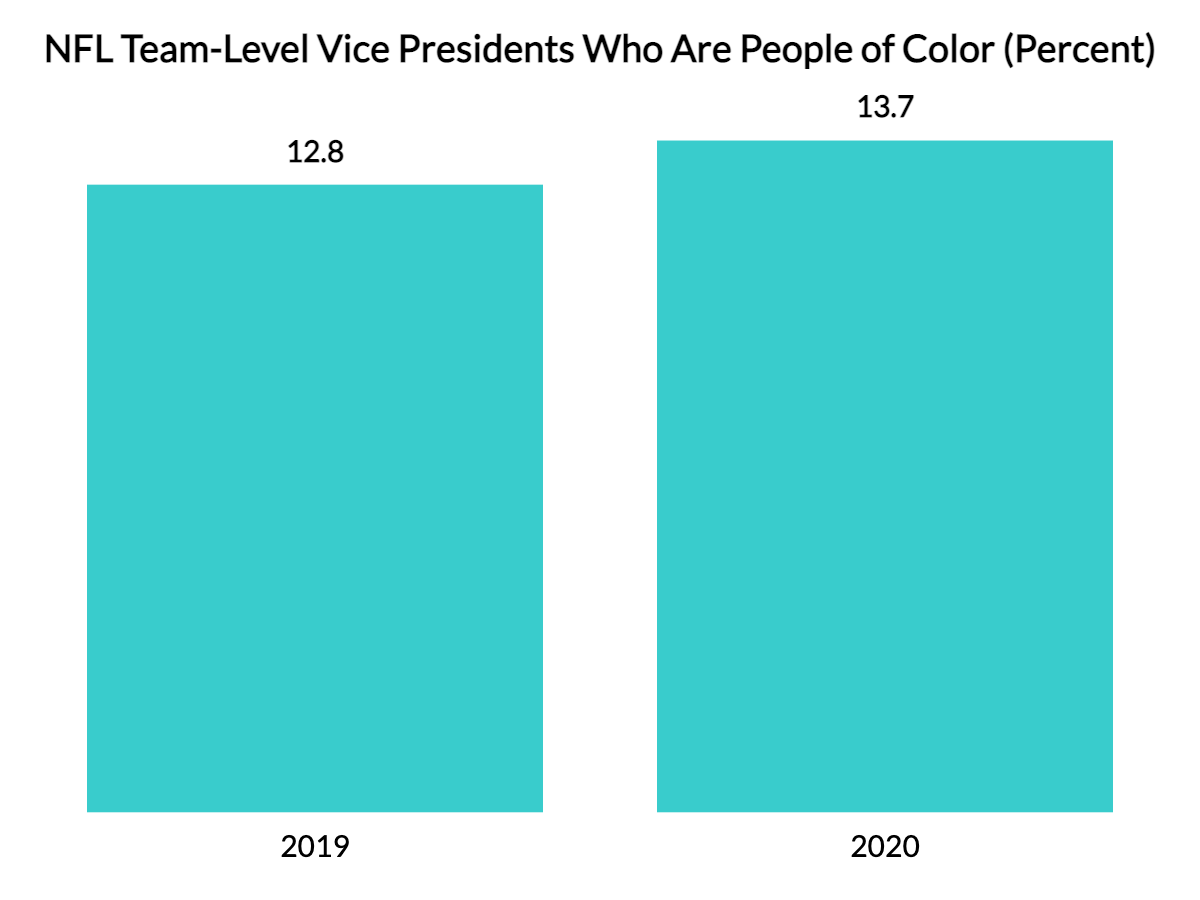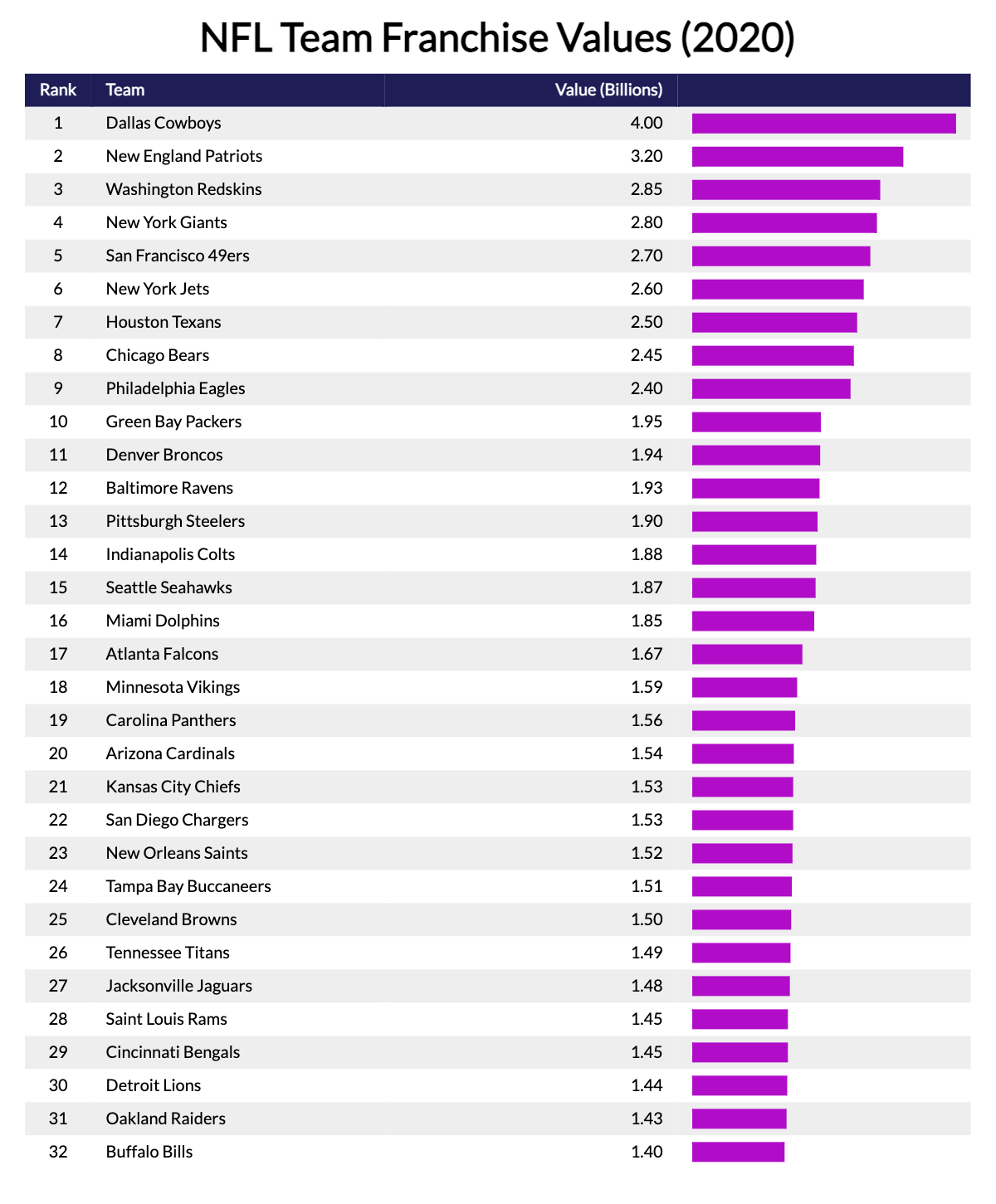Research Summary. According to the National Football League demographic and financial statistics, even though players are primarily people of color, most management, coaching, and official positions are held by male non-people of color. Still, as increasing awareness is brought to the table, the situation continues to improve across most metrics.
After extensive research, our data analysis team concluded:
-
The NFL’s total 2020 revenue was $12.2 billion, a decrease from $15.26 billion in 2019.
-
The average franchise value of an NFL team is $3.04 billion.
-
According to TIDES data, the NFL received an overall racial hiring grade of B+ and a gender hiring grade of C.
-
As of 2020, 69.4% of National Football League players were people of color.
-
About 14.9 million people watch a regular-season NFL game on TV, compared to 3.9 million for the NBA, 2.1 million for MLB, 1.3 million for NHL, and 1.0 million for MLS.
For further analysis, we broke down the data in the following ways:
Gender | General Financial | Fan

National Football League Statistics by Race
-
In 2020, 69.4% of National Football League players were of color, a decrease of 3.2% from 2016.
The percentage of Black or African-American NFL players reached 57.5%, Whites 24.9%, Hispanics or Latinos 0.4%, Asians 0.1%, Pacific Islanders 1.6%, and American Indian 0.2%. 9.4% of players identified as two or more races.
All of this gave the NFL a TIDES racial score of 85.5% in 2020 and a B+ for racial hiring practices. Here’s a high-level summary of the NFL’s report card scores across all racial categories:
TIDES NFL Racial Report Card Scores Category Grade Overall Racial Hiring B+ Race of NFL Players A+ Head Coaches D+ Assistant Coaches A+ GMs/Principal-in-Charge F CEOs/Presidents D+ Senior Administration B Professional Administration B+ NFL Players A+ Head Coaches D+ Assistant Coaches A+ League Office A+ CEOs/Presidents D+ C-Suite Executives C- Vice Presidents C- -
When it comes to head coaching positions, Black or African-American representation dropped to 9.4% in 2020, while 12.5% of head coaches were of color.
Here’s a table outlining the racial differences in head coaching positions across the NFL:
People of Color Representation Among NFL Head Coaches Year White Hispanic or Latinx Black or African American 2010 24 1 7 2011 26 1 5 2012 28 1 3 2013 27 1 4 2014 26 1 5 2015 26 1 5 2016 24 1 7 2017 24 1 7 2018 26 1 3 2019 28 1 3 -
14.5% of League Office vice presidents and above are people of color, an increase from last year.
Furthermore, 13.7% of team-level vice presidents are people of color, increasing from 12.8% last year. When it comes to management roles, 30.5% are POC, which is a record high.

-
As of 2019, among the 251 broadcasters who work with the NFL’s TV and radio partners, 49 (less than one-fifth) were Black.
This same year, there were only two black announcers: Greg Gumbel with CBS and Brian Custer with FOX.
-
In 2020, Jason Wright of the Washington Football Club became the first Black team President in NFL history.
Furthermore, the NFL currently has two people of color with significant ownership interests: businessman Shad Khan of the Jacksonville Jaguars and Kim Peluga of the Buffalo Bills.
-
The NFL’s 2020 TIDES score for race is 85.5%, which is an increase from 82.3% in 2019. However, the overall grade for the NFL decreased from 79.3% in 2019 to 79.2% in 2020.
Several factors that led to these changes include:
-
An increase in assistant coaches of color from 33.6% in 2019 to 35.6% in 2020;
-
An increase of people of color in management positions within the League Office;
-
An increase of people of color in professional administration positions from 20.7% in 2019 to 24.1% in 2020.
However, the NFL saw their score decrease based on team senior administration, as well as the fact that the combined number of POC officials decreased from an all-time high record of 39 in 2019 to 34 in 2020.

-
National Football League Statistics By Gender
-
The NFL’s 2020 TIDES score for gender is 73%, which represents a decrease from 2019’s score.
There were two female assistant coaches for the 2020 season, Jennifer King (who is also a person of color) and Callie Brownson, as well as a female official, Sarah Thomas.
However, both team senior administration and team professional administration levels experienced decreases in TIDES gender scores. Here’s how they stacked up against the NFL’s other positions:
TIDES 2020 NFL Gender Report Card Scores Category Grade Overall Gender Hiring C League Office B CEOs/Presidents F Senior Administration F Professional Administration C+ C-Suite Executives D+ Vice Presidents F -
When it comes to the NFL League Office, the overall percentage of women involved was 38.2% in 2020, which was an increase from 36.8% in 2019.
This was also an increase of nearly nine percentage points since 2014.
In addition, the percentage of women in vice president roles or above increased from 29.6% in 2019 to 31.5% in 2020. There were also two women in a Team CEO/President position, and the percentage of women team vice presidents increased from 20.7% in 2019 to 21.1% in 2020.
-
When it comes to gender, the NFL saw significant changes in team administration positions.
In 2020, women held 23.9% of team senior administration positions and 32.3% of team professional administration positions, which decreased from 2019’s 24.4% and 35.9%, respectively.
31.5% of the vice president and above positions are represented by a woman, while a woman represents 21.1% of the vice president positions at the team level.

National Football League General Financial Statistics
-
In 2019, the National Football League brought in more than $15 billion, a drastic increase compared to $4.2 billion in 2001.
Although the COVID-19 pandemic caused the figure to drop to $12.2 billion in 2020, the NFL remains the most profitable professional sports league in the United States. Here’s how the numbers play out across the past two decades:
Total Revenue of All National Football League Teams Year Revenue (Billions) 2001 4.28 2002 4.94 2003 5.33 2004 6.03 2005 6.16 2006 6.54 2007 7.09 2008 7.57 2009 8.02 2010 8.35 2011 8.82 2012 9.17 2013 9.58 2014 11.09 2015 12.16 2016 13.16 2017 13.68 2018 14.48 2019 15.26 2020 12.2 Comparatively, Major League Baseball (MLB) had a revenue of about $10.37 billion, the National Basketball Association (NBA) about $7.92 billion, and the National Hockey League (NHL) about $4.37 billion in 2019.
-
The average franchise value of an NFL team is $3.04 billion.
The Dallas Cowboys, who generated $800 million in revenue during 2020 and are the highest-grossing team in the league, top the list with an operating income of $280 million and an estimated value of $5.7 billion. The next closest is the New England Patriots, which have a franchise value of $5 billion.
At the other end of the spectrum is the Buffalo Bills, which have an estimated worth of $2.05 billion, and the Los Angeles Chargers with an operating income of -$49 million.
Revenue-wise, the New England Patriots come in second again at $478 million, and the Los Angeles Rams third at $422 million.

-
As an organization, the NFL has many revenue streams.
Typical streams include:
-
Sponsorships ($1.62 billion expected in 2021);
-
Media (both broadcast and digital);
-
Partnerships;
-
Ticket and concession sales (1.25% of the NFL’s total revenue in 2020);
-
Television rights.
On average, an NFL team earned about $7 million in ticket sales per stadium event during 2016, on which they earned about 8% profit. Expenses include:
-
Athletes/musicians: 55%
-
General stadium administration: 10%
-
Coaching staff: 5%
-
Taxes: 5%
-
National Football League Fan Statistics
-
Among professional sports leagues, the NFL boasts the highest per-game attendance.
On average, an NFL game draws 66,000+ spectators, with more than 16 million total during the 2019 season. About 14.9 million people watch a regular-season NFL game on TV.
-
The Super Bowl is one of the biggest single-day sports events in the world.
Super Bowl 55 boasted 91.6 million TV viewers (96.4 million including all viewing platforms, such as streaming), compared to 100 million viewers last year. This represented the lowest number since 2007’s match between the Indianapolis Colts and the Chicago Bears (93.2 million TV viewers, or 96.4 million combining other platforms).
Super Bowl TV Viewership Year Number of TV Viewers (Millions) 2007 93.18 2008 97.45 2009 98.73 2010 106.48 2011 111.01 2012 111.35 2013 108.69 2014 112.19 2015 114.44 2016 111.86 2017 111.32 2018 103.39 2019 98.19 2020 100.45 Depending on the source, the Super Bowl generates between $30 million and $500 million for host cities, in addition to millions of dollars in ad revenue for the league and billions of in-store merchandise sales and other consumer spending leading up to the game.
National Football League Demographics And Financials FAQ
-
What percentage of NFL team revenue goes to player salaries?
About 55% of an NFL team’s revenue goes to player salaries.
-
How much do NFL players earn per season?
While the average annual NFL salary is over $2 million, the median is just $860,000. Each team has a salary cap of $188.2 million.
-
What’s the percentage of players of color in the NFL?
As of 2020, 57.5% of NFL players were Black, 0.4% Hispanic or Latinx, 0.1% Asian, 1.6% Pacific Islander, and 0.2% American Indian.
-
What is the NFL’s annual revenue?
The NFL’s total revenue for 2020 was $12.2 billion.
-
How much is an NFL team worth?
The average 2020 value of an NFL team is $3.04 billion.
Conclusion
According to TIDES data, the NFL is making progress in racial and gender diversity for many different positions, both on and off the field. And while the NFL’s revenue dropped significantly between 2019 and 2020, many experts expect this number to rebound for the 2021 season.
Sources
-
The Institute for Diversity and Ethics in Sport. The 2020 Racial and Gender Report Card – National Football League. Accessed on 9/28/21.
-
Statista. Total revenue of all National Football League teams from 2001 to 2020. Accessed on 9/29/21.
-
Statista. National Football League (NFL) – Statistics Facts. Accessed on 9/29/21.
-
Statista. National Football League revenue by team in 2020. Accessed on 9/29/21.
-
Statista. Operating income of National Football League teams in 2020. Accessed on 9/29/21.
-
Investopedia. How The NFL Makes Money. Accessed on 9/29/21.
-
Sporting News. How many people watched Super Bowl 55? Ratings, viewership numbers take big hit in 2021. Accessed on 9/29/21.
-
Sports Media Watch. Super Bowl Ratings History (1967-present). Accessed on 9/29/21.
-
Business Insider. Why hosting the Super Bowl isn’t worth it, according to an economist. Accessed on 9/29/21.
-
CNBC. The Super Bowl is worth billions each year — Here’s who makes what. Accessed on 9/29/21.
-
Statista. Average television viewership of the NFL regular season from 2010 to 2020. Accessed on 9/29/21.
-
The Guardian. The NFL is 70% black, so why is its TV coverage so white? Accessed on 9/30/21.
-
Chron.com. How Much Money Does an NFL Player Make a Year? Accessed on 9/30/21.





